We take a look at the two recent TVCs – ‘Baby’ for the Foundation Against Cancer and ‘Manipulation’ for Audi – featuring visual effects work from Glassworks, completed in Amsterdam and London.
‘Baby’ – Foundation Against Cancer
In ‘Baby’, a spot from Belgian agency Openhere for the non-profit Foundation Against Cancer that depicts an unborn baby in the womb, Glassworks was tasked with creating the photorealistic baby from a variety of close angles.
[s2If !current_user_can(access_s2member_level1)]
[/mepr-show]
Reference for the look and feel of a baby came initially from photographs. “In the very first meeting,” recalls Glassworks head of 2D Morten Vinther, “we looked through a book about unborn babies that takes you through the stages of the baby being born. We saw a few pictures in there where the baby was either backlit or really frontlit with a spotlight. The decision was to go with the backlit scene. We also saw pictures where there were all kinds of particulates floating around the womb.” Further reference of ultrasound images and footage, including 3D-like renderings, were also used.
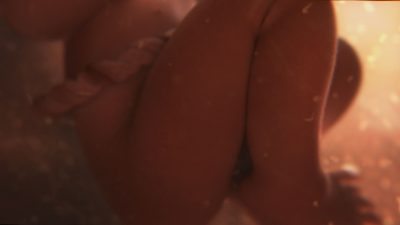 Those reference images informed the 3D model of the baby. “It was actually quite easy to get a basic shape going,” says 3D artist Dan Hope, “but a lot of time with the modeling was really getting a natural form, especially with the hands and feet. The client also wanted the baby to be as cute as possible, so we spent a lot of time tweaking the face.”
Those reference images informed the 3D model of the baby. “It was actually quite easy to get a basic shape going,” says 3D artist Dan Hope, “but a lot of time with the modeling was really getting a natural form, especially with the hands and feet. The client also wanted the baby to be as cute as possible, so we spent a lot of time tweaking the face.”
The angles chosen came from an early rendering of the baby model. “We took the model and did a previs with it,” explains 3D artist Markus Lauterbach. “We rendered out say 20 or 30 different angles and camera moves to find the most interesting parts of the baby to look at. Then we started cutting those together. After about 15-20 different edits, we had a cut we had agreed on.”
“There were a lot of conversations about the lens we were going to use,” adds Lauterbach, “because obviously we had a very confined space, but then as soon as you shoot something on a very wide lens and you get close to the anatomy of the head, the head starts to look kind of weird and alien-like.”
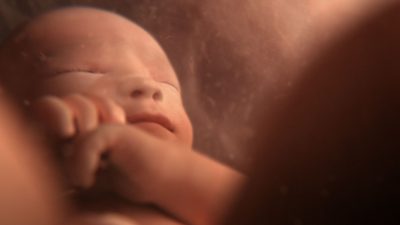 Textures for the skin were referenced from photographs taken of a Glassworks employee’s one week old baby. “We were we were amazed at all the imperfections we could see in the skin,” says Lauterbach. “Normally if you think of a baby you think of this perfect skin with no spot on it. It was actually the very opposite. That’s what we used to get the bump and displacement going on the skin.”
Textures for the skin were referenced from photographs taken of a Glassworks employee’s one week old baby. “We were we were amazed at all the imperfections we could see in the skin,” says Lauterbach. “Normally if you think of a baby you think of this perfect skin with no spot on it. It was actually the very opposite. That’s what we used to get the bump and displacement going on the skin.”
The animation of the baby’s body and limbs remained subtle, along with slight facial movements. Says Dan Hope: “For the facial animation, we filmed one of our colleagues with tracking markers all over her face and used that to transpose the animation onto the baby. With the rest of the body, it was important to get the body interacting with each other, and the feet and arms moving, but without it being too distracting.”
For rendering, Glassworks relied on Arnold, heavily utilizing sub-surface scatting. Artists also added fine hair and flakes of displacement in order to catch highlights. The underwater look came also from practical elements shot in a small water tank. “We had this set up with some macro lenses,” explains Morten Vinther, “and started experimenting with different liquids that were put into this water to get the feel we had stringy bits and had organic looking particles. The thing that actually looked the best was glue, which gave us long streaky bits that had the right organic look. We combined the shot elements with particle systems that we built in Flame and in XSI.”
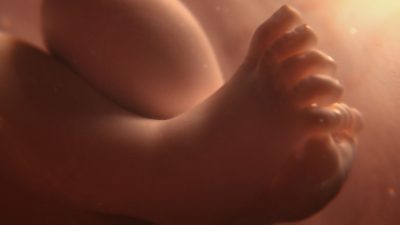 “On top of that,” continues Vinther, “we had lots of procedural texturing going on. We had a grade based on the depth of the image to remove red as we go further back into it. We had very different region maps for areas of the water that needed to be warped in a particular kind of way, to make it more interesting looking and more dense in parts.” Some final warping in the Flame helped with some lens distortion for the slightly wider shots, rounding up around two months work for the Glassworks team.
“On top of that,” continues Vinther, “we had lots of procedural texturing going on. We had a grade based on the depth of the image to remove red as we go further back into it. We had very different region maps for areas of the water that needed to be warped in a particular kind of way, to make it more interesting looking and more dense in parts.” Some final warping in the Flame helped with some lens distortion for the slightly wider shots, rounding up around two months work for the Glassworks team.
‘Baby’ Credits
Advertising Agency: Openhere
Creative Director: Stijn Gansemans
Copywriter: Koen van Deun
Art director: Johan Roelandt
Glassworks Team
Flame: Morten Vinther
3D Artists: Dan Hope, Markus Lauterbach, Martin Contel
Producer: Evelien Schenkkan
‘Manipulation’ – Audi A6
A whole different set of requirements fell upon the Glassworks team for ‘Manipulation’, a commercial for the Audi A6 showing the vehicle being hand-crafted and engineered by pushing, pulling and smoothing over metal blocks into final car pieces.
Watch ‘Manipulation’For Glassworks, the visual effects had to be as natural and photoreal as possible. “The whole purpose behind it was to make it real but fantastical,” says producer Misha Stanford-Harris. “It had to have some elements of magic but be based in realism. So the way the actor’s fingers move had to have a direct impact and response on the material that he’s moving. They never wanted it to be unbelievable that his fingers might not be able to do that.”
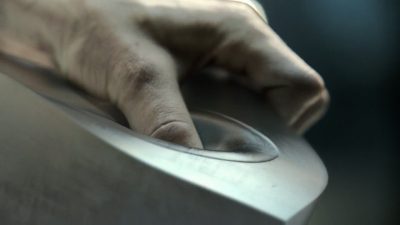 The studio spent some time early in pre-production testing to help settle on the right weight and density of the metal. On set, stand-in blocks of metal and props generally made out of clay were used. Ultimately, every piece of metal was replicated digitally by Glassworks. “Even the blocks at the beginning, which are solid blocks of metal, were actually all replaced in CG,” notes Stanford-Harris. “What they did was build art-directed blocks of metal and then because of the particular textural quality we were looking for, it made sense for us to completely replace all the metal in the ad for consistency.”
The studio spent some time early in pre-production testing to help settle on the right weight and density of the metal. On set, stand-in blocks of metal and props generally made out of clay were used. Ultimately, every piece of metal was replicated digitally by Glassworks. “Even the blocks at the beginning, which are solid blocks of metal, were actually all replaced in CG,” notes Stanford-Harris. “What they did was build art-directed blocks of metal and then because of the particular textural quality we were looking for, it made sense for us to completely replace all the metal in the ad for consistency.”
For shots of the actor digging his hand into the metal block, he would actually push his fingers into a large piece of clay that was ultimately replaced with a CG object. This, according to Stanford-Harris, “had to be an engineered shape – not just like a shape you would find if you put your finger into clay. It had to feel like it was actually starting to form a machined or milled hole. There’s also a shot where he’s pulling the metal across himself. Here he was holding a block of clay on one end and then it’s actually joined by cling film in the middle – just something to give him tension and some resistance.”
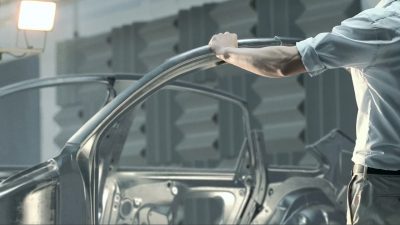 To create the metal blocks, and subsequent vehicle parts and panels, artists first had to track the prop, as well as the hand and body motion of the actor. “The stand in props were covered in tracking dots to allow us to mimic the movement of the original pieces as closely as possible,” explains lead 3D artist Nick Smalley. “Tracking the objects precisely played a major part in selling the illusion. Our CG hands also had to match the actors movements exactly to get accurate reflections and shadows. When you’re dealing with something interacting with CG so close up you can’t get away with anything, as just a small mistake would break the believability.”
To create the metal blocks, and subsequent vehicle parts and panels, artists first had to track the prop, as well as the hand and body motion of the actor. “The stand in props were covered in tracking dots to allow us to mimic the movement of the original pieces as closely as possible,” explains lead 3D artist Nick Smalley. “Tracking the objects precisely played a major part in selling the illusion. Our CG hands also had to match the actors movements exactly to get accurate reflections and shadows. When you’re dealing with something interacting with CG so close up you can’t get away with anything, as just a small mistake would break the believability.”
Vehicle parts were created in 3D using actual Audi CAD data, re-worked to match the pieces ‘manipulated’ on set. “They used the actual piece from the car and added some clay on top,” says Standford-Harris. “This meant that when he’s smoothing his finger along the edge, he’s actually pushing into something, so you get that natural resistance going on.”
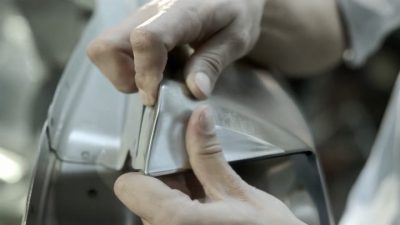 Photographs of real blocks and vehicle panels were used to paint textures. In addition, HDR images of the set allowed artists to re-build environments in 3D, so that appropriate reflections could be added to the metal pieces.
Photographs of real blocks and vehicle panels were used to paint textures. In addition, HDR images of the set allowed artists to re-build environments in 3D, so that appropriate reflections could be added to the metal pieces.
“We survey the set and take accurate measurements and lots of photographs to enable us to recreate the entire scene in 3D,” says Smalley. “That, combined with the HDR images, gives us a basis for the lighting. We then tailor the lighting specifically to each shot depending on the camera and create highlights that are aesthetically pleasing.”
For the final shots the vehicle nearing completion, Glasswork re-built part of the set environment and the plinths the car was resting on. The car, which slowly transforms into a completed object as it rotates, was shot on a turntable multiple times, and then built up to show finished glass, bumpers and mirrors in compositing.
‘Manipulation’ Credits
Director: Adam Berg
Production Company: Stink
Production Company Producer: Ben Croker
DoP: Joost Van Gelder
Editor: Paul Hardcastle @Trim
Advertising Agency: BBH
Agency Creative: Nick Kidney
Agency Creative: Kevin Stark
Art director: Dan Bailey
Copywriter: Bradley Woolf
Agency Producer: Ruben Mercadal
Glassworks team
3D Lead: Nick Smalley
3D Artists: Stephen New, Andreas Bystrom, Roman Kaelin, Jon Bragado
Flame Lead: Duncan Malcolm
Flame assist: Iain Murray
TK Colourist: Ben Rogers
Producer: Misha Stanford-Harris
